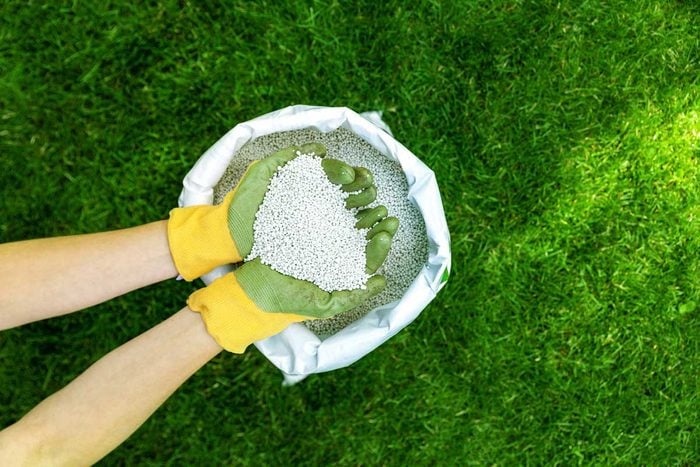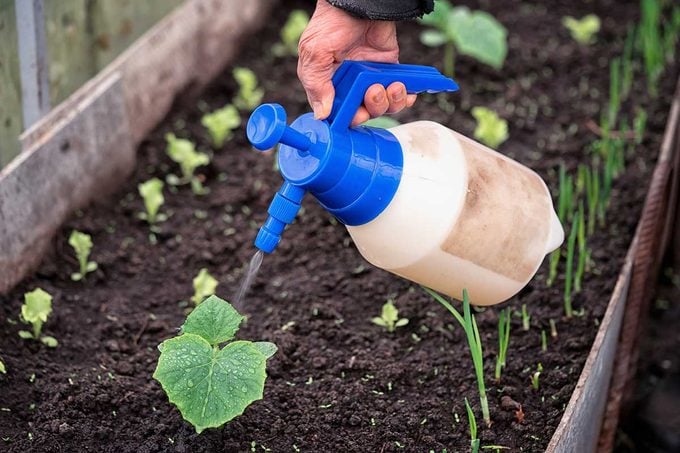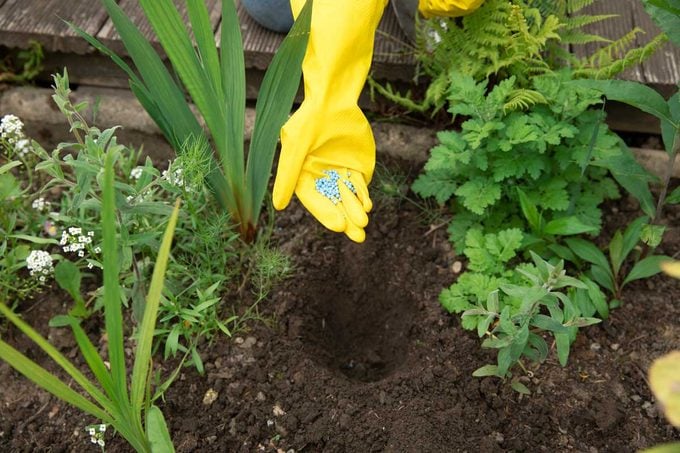Homeowner’s Guide to Garden Fertilizers
Updated: Sep. 08, 2023

Here's how to fertilize plants, plus pro tips on what works best on some of the most popular garden plants and vegetables.
Should you go with granular or liquid — or maybe fertilizer spikes? Slow release or quick release? Organic or synthetic? Do you even need to fertilize and if so, when should you apply it?
Fertilizing your garden shouldn’t have to be so complicated! But with a huge variety of fertilizers on the market and different solutions for different plant types, it’s difficult to know where to start.
We reached out to Diane Blazek, executive director at the National Garden Bureau (NGB), who consulted the experts on the NGB team. They shared their expertise on fertilizing plants, including when to fertilize and how to pick the best fertilizer for your garden.
On This Page
Why Fertilize Plants?
Fertilizing plants encourages healthy growth. “Think of it as humans needing food,” Blazek says. “We deplete what we take in. A vigorous one-year plant, like annuals and most vegetables, depletes the ‘food’ in the soil, so we need to replenish nutrients throughout the growing season.”
This is especially true with plants growing in containers, according to the NGB experts. Nutrients can leach out of the soil through the bottom of the container and leave the plants starved for nutrients.
Types of Plant Fertilizers
Virtually all fertilizers have an NPK value, which stands for the ratio of nitrogen (N), phosphorus (P) and potassium (K) in the fertilizer mix. It shows up as a series of three numbers, such as 10-15-10. An all-purpose fertilizer will typically have a balanced NPK value, while specialty fertilizers have adjusted ratios of NPK, depending on what a specific nutrient a plant needs.
Fertilizers are made with synthetic ingredients or organic byproducts like manure, blood or bone meal, or seaweed. Which one you choose depends largely on personal preference. Synthetic fertilizers are generally fast-acting, but some gardeners prefer organic products, especially for their food crops.
However, there are downsides to using organic fertilizers for a home garden:
- Pets may think organic fertilizer is a tasty snack;
- Organic fertilizer takes longer to work, although many gardeners feel it yields better results;
- Organic fertilizer is often more expensive than synthetic.
Whether organic or synthetic, fertilizer comes in the following forms:
Granular Fertilizer
Manufactured as grains or pellets, granular fertilizer is applied on top or mixed directly into the soil. It comes in two forms:
- Quick-release fertilizer dissipates into the soil when watered, but starts working right away. It needs to be reapplied every few months.
- Slow-release, or controlled-release fertilizer has to be worked into the soil and will release nutrients over several months.
Liquid Fertilizer

It’s sold in two forms — a powder to be mixed with water, or a liquid concentrate that must be diluted with water before application. These quick-release products give fast results but need to be reapplied during the growing season. Get to know the difference between plant food and fertilizer.
Fertilizer Spikes
Like slow-release fertilizers, fertilizer spikes gradually break down once they’re driven into the soil. They make it easy for gardeners to target specific plants with fertilizer, but are not practical for a large area.
How and When to Fertilize Specific Plants
According to the NGB, there is no specific right time to fertilize all the plants in your garden. Timing depends entirely on the type of individual plant. Fortunately, Blazek and the NGB offered us tips on when and how to fertilize some of the most popular annuals and vegetables, and which ones most likely need fertilizing.
Note that the term “side dress” means to dig a one- to two-inch deep circular furrow just outside the circumference of the plant’s leaf-spread. Apply fertilizer in the trench and cover it with soil. In rows of vegetables, you can create long, straight furrows between the rows.
Fertilizing Your Favorite Vegetables
- Cucumbers. “Cucumbers are among the thirstiest of vegetables and prefer long, deep watering rather than frequent sprinklings,” Blazek says. “They are also heavy feeders so side dress with 5-10-10 fertilizer at the time of planting and once a month thereafter.”
- Squash. “Mix in a slow-release fertilizer to the soil before planting or use a pre-made potting mix with a slow-release fertilizer,” Blazek says.
- Peas. “Use fertilizer sparingly as too much nitrogen can encourage more leaf production than pods,” Blazek says.
- Tomatoes. “Start your plants off with an ample shovelful or two of compost to improve the soil,” Blazek says. “You can also use synthetic or organic fertilizers. Some types, such as water-soluble granules or fish emulsion, can be applied when watering. There are also granular forms that are mixed with the soil before planting or used as a side dressing, and time-release fertilizers, which can be added to the soil at planting time.” For tomatoes, the NGB suggests a fertilizer that contains more phosphorus (P) than nitrogen (N) or potassium (K) because phosphorus promotes flowering and fruit set (when the flower starts to form into a fruit).
- Peppers. Fertilize peppers about every two weeks, but stop fertilizing once the plant is in bloom so it can put its energy into the fruit set.
- Eggplant. With eggplant, Blazek says to work in a balanced, time-release fertilizer with the soil at the time of planting.
Fertilizing Your Favorite Flowers and Bulbs
- Echinacea and Rudbeckia. These coneflowers come in a range of colors and varieties and are popular for a reason — they’re low-maintenance. If you start with a nutrient-rich potting soil mix, no additional fertilizing is needed during the growing season. Blazek says fertilizing will lead to tall, leggy plants that flop over.
- Petunias. For prolific blooms, fertilize petunias every couple of weeks with a diluted liquid fertilizer solution. When deadheading or pruning, fertilize afterward to promote new growth and blooms.
- Zinnias. Zinnias aren’t particularly heavy feeders, Blazek says, but fertilizing plantings at least twice during the growing season will yield lots of colorful blooms. “Use a balanced granular or water-soluble fertilizer, for instance one with 20-20-20 on the label, or mix a slow-release or organic fertilizer into the soil when you plant,” Blazek says. For container plants, mix a timed-release or organic fertilizer into a soil-less potting mix when you plant the zinnias, or feed them once a month with a water-soluble fertilizer or diluted fish emulsion. Always follow label directions for amounts, and be sure to dilute to the strength recommended on the label for containers.
- Hydrangeas. Fertilize hydrangeas in the spring as they come out of dormancy and start to leaf out, Blazek says. Use a low-strength, balanced fertilizer, like a 5-5-5, spread out over the root ball. It’s not necessary to fertilize a second time but if you do, do so prior to July, then hold off again until next spring.
- Bulbs. When you plant bulbs, use a bulb food with a good dose of phosphorus, like bone meal, in the planting hole. In spring, you can fertilize just when new green shoots start to appear, although Blazek says this isn’t a must. Top dress (meaning apply the fertilizer on the soil surface or just under the surface) with a balanced 5-10-5, 10-10-10 or 10-15-10 slow-release fertilizer. Blazek says the most important thing for spring-flowering bulbs is to let the leaves to remain on the plant and die back naturally, to generate and store food for next year’s display.

Fertilizer Pro Tips
For a garden that contains a mix of vegetables, fruits and ornamental plants, there’s no one-size-fits-all fertilizer. In addition to the recommendations above, check the information on the plastic tags or seed packets when you do your planting. Your local nursery or home center will likely stock fertilizers that are suited to your climate. When in doubt, consult an expert at a nursery.
Also consider these tips from the pros at the NGB:
- No matter what kind of fertilizer you choose, always follow the directions on the label.
- Applying too much or the wrong type of fertilizer, especially synthetics, can “burn” plants and ultimately kill them.
- Over-fertilizing vegetables and fruits will result in lush plants but little vegetable or fruit production.
